Belize, located in Central America, is home to a variety of birds that can be found in its numerous forests and wetlands. With more than 500 species of birds living in the country, Belize provides many opportunities for bird-watching enthusiasts to view some of the most beautiful and unique birds in the world.
From parrots and toucans to ospreys and hummingbirds, Belize is a haven for bird-lovers, offering a wide variety of spectacular species that make the country a paradise for bird-watchers.
1. Keel-Billed Toucan
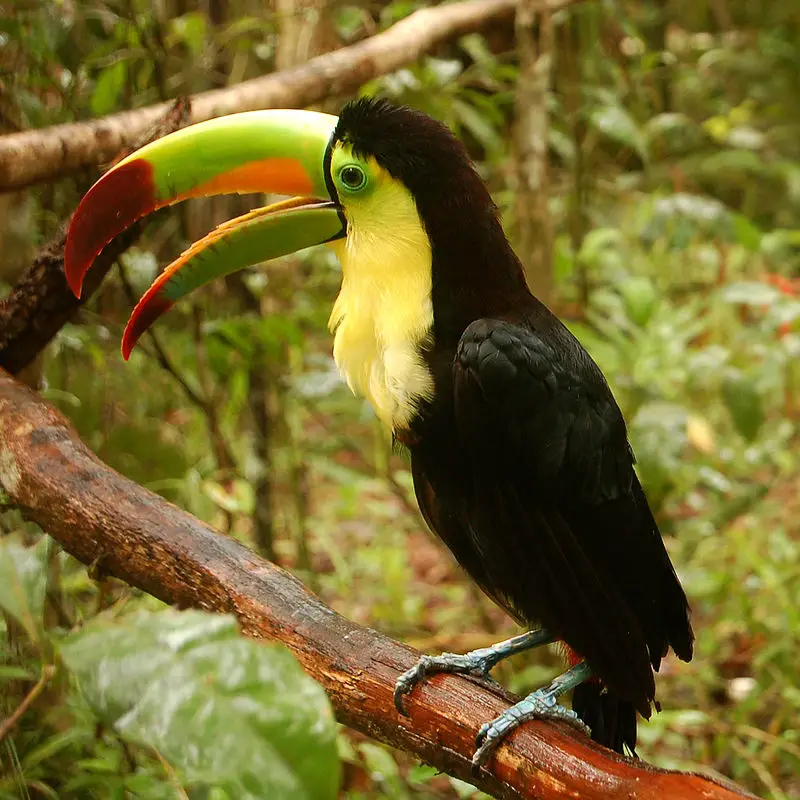
The Keel-billed Toucan is a vibrant Latin American bird from the toucan family and also serves as Belize’s national bird. They are found in tropical jungles stretching all the way from southern Mexico to Colombia.
They feed on fruits, seeds, insects, lizards and snakes – being omnivorous birds they eat pretty much anything.
These colourful creatures have an impressive beak with green upper parts of their bodies coupled with yellow lower halves.
The underside of their tail feathers are black while its tips remain white creating for quite a stunning display when flying or perched atop tree branches.Scientific classification:
| Kingdom | Animalia |
| Phylum | Chordata |
| Class | Aves |
| Order | Piciformes |
| Family | Ramphastidae |
| Genus | Ramphastos |
| Species | R. sulfuratus |
2. Yellow-Headed Amazon
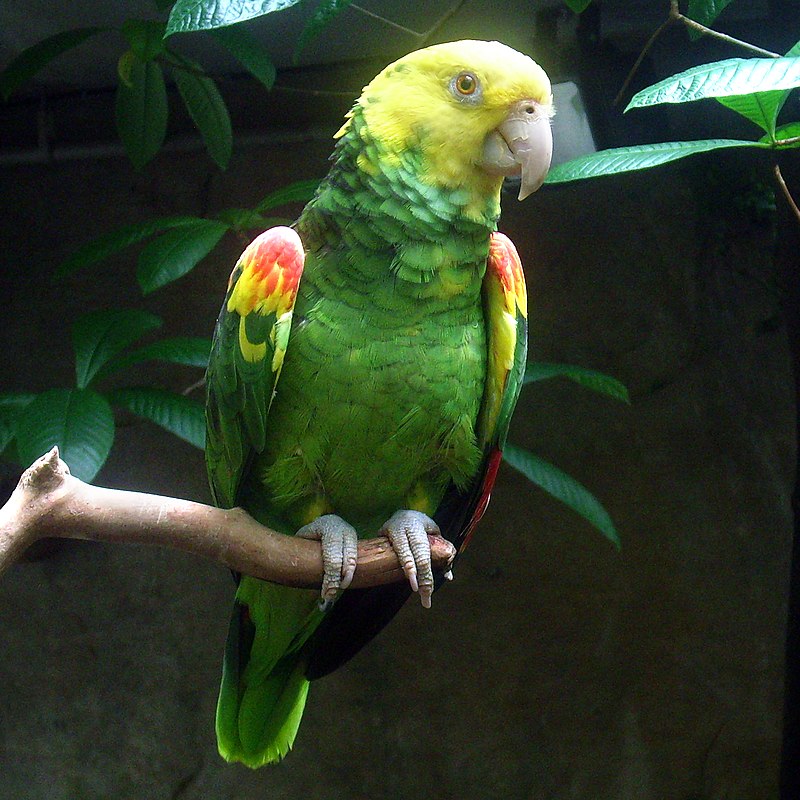
The Yellow-headed Amazon is an endangered species of parrot native to Mexico and northern Central America. It has a stocky, short-tailed body with bright green feathers and a distinct yellow head.
This bird prefers living in mangrove forests or near rivers or other bodies of water, as it requires plenty of moisture for its survival.
The Yellow-headed Amazon can measure between 15” – 17” (38 cm – 43 cm) from beak to tail, making them the largest member of their genus found in the New World.
They are social birds that live together in flocks year round; however they become more dispersed during breeding season when males will often form pairs with females nearby but away from the main flock.
Unfortunately due to habitat loss deforestation this species faces increasing threats and thus needs our help if we want them around for future generations.Scientific classification:
| Kingdom | Animalia |
| Phylum | Chordata |
| Class | Aves |
| Order | Psittaciformes |
| Family | Psittacidae |
| Genus | Amazona |
| Species | A. oratrix |
Also Featured In: Case Birds that Live in with Us, Green Birds Commonly Found in Florida
3. Black-Headed Trogon
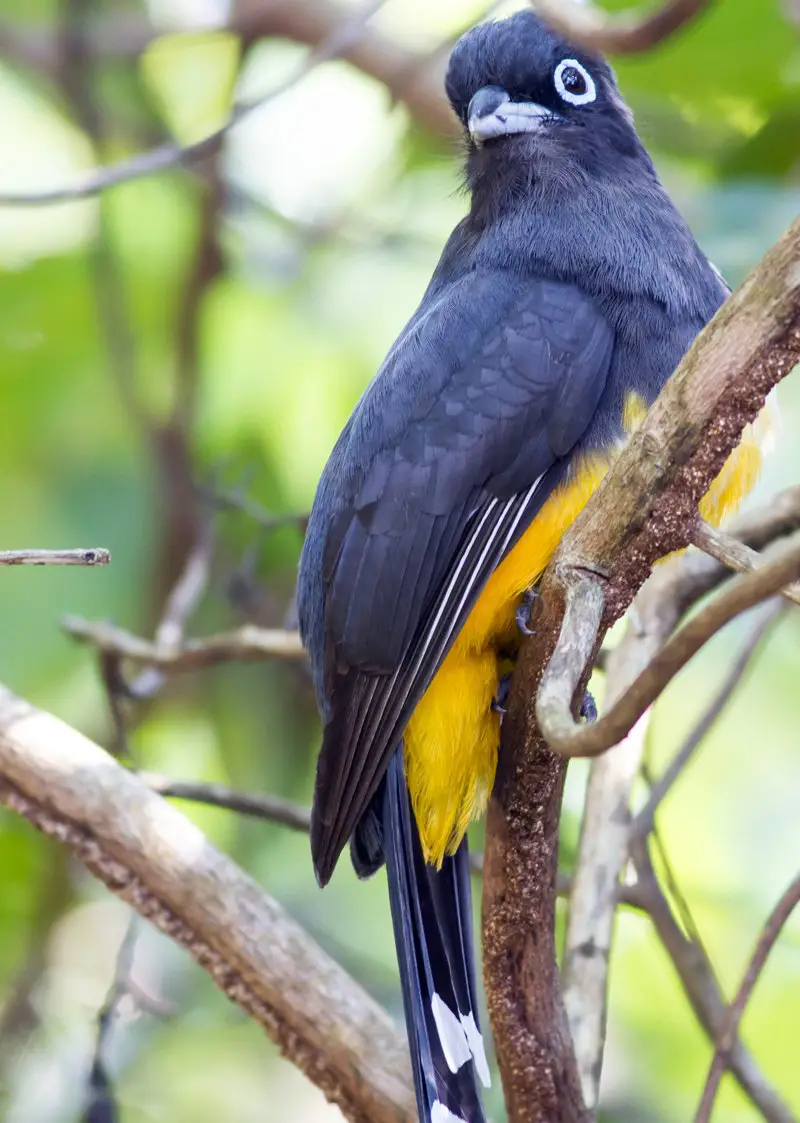
The Black-headed Trogon is a species of bird belonging to the family Trogonidae. It mainly resides in Central America, such as Belize, Costa Rica, El Salvador and Mexico.
The International Ornithological Committee and BirdLife International’s Handbook of the Birds of the World consider this species monotypic.
Clements taxonomy assigns it two subspecies – T. m. melanocephalus found from Honduras to Nicaragua; while T. m leucolaemus can be spotted in Guatemala and Chiapas (Mexico).
Its feathers are mostly black with white tips on wings & tail tip with red undertail coverts that make its appearance unique when seen against sunlight or bright background.Scientific classification:
| Kingdom | Animalia |
| Phylum | Chordata |
| Class | Aves |
| Order | Trogoniformes |
| Family | Trogonidae |
| Genus | Trogon |
| Species | T. melanocephalus |
4. White-Fronted Amazon
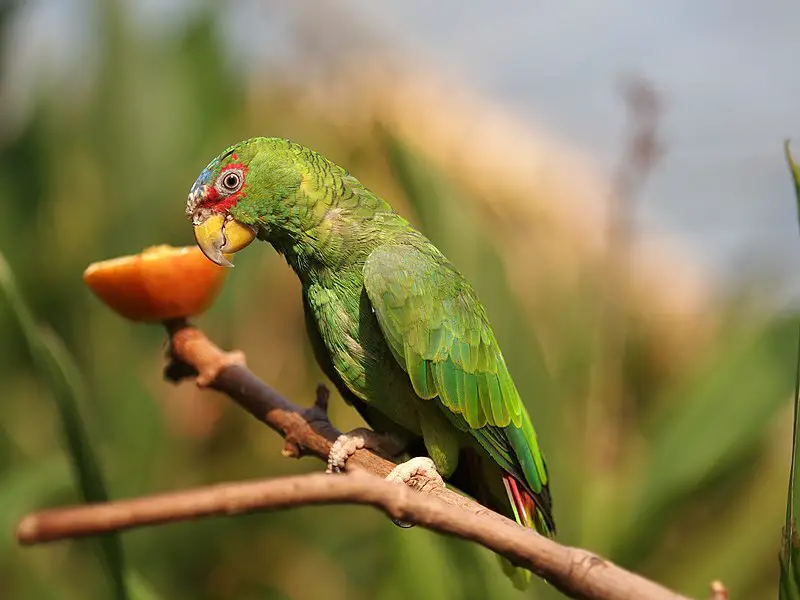
The white-fronted amazon is a Central American parrot that stands out for its bright colouring and ability to imitate around 40 different sounds.
It has an average life span of about 40 years, making it one of the longest living parrots in existence.
Despite being the smallest species among large parrots, measuring 25cm long, this bird still possesses strong vocal chords which can be heard from great distances.
They have beautiful yellow heads with distinctive white patches on their forehead and grey feathers covering their wings and tail.
These birds are very social animals who live in pairs or family groups within tropical rainforests and wetlands where they feed mostly on seeds found in trees such as palms.Scientific classification:
| Kingdom | Animalia |
| Phylum | Chordata |
| Class | Aves |
| Order | Psittaciformes |
| Family | Psittacidae |
| Genus | Amazona |
| Species | A. albifrons |
5. Slaty-Tailed Trogon
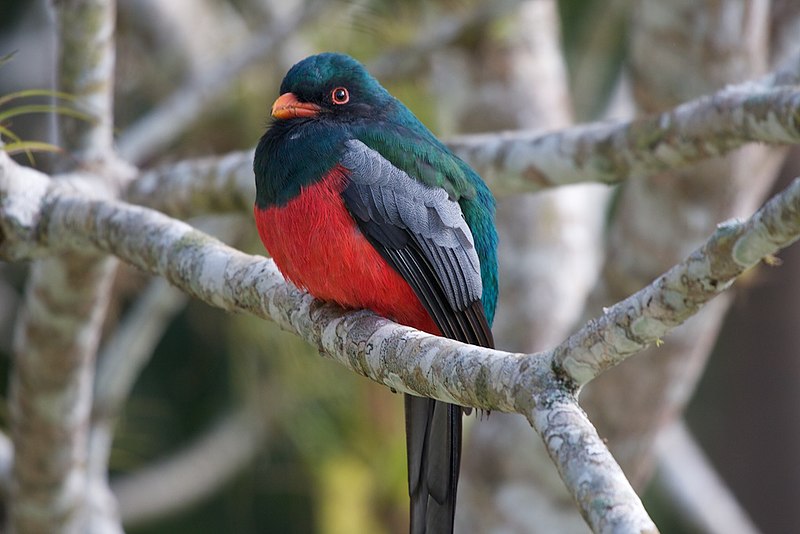
The Slaty-tailed Trogon is a medium sized bird that can be found in Mexico, Central America, Colombia and Ecuador. It has three subspecies – the nominate T.
m. massena, T. m Hoffmannni and T Austrialis which have sometimes been treated as separate species from the Black tailed trogon family instead of its own subspecies due to their distinct physical traits such as size differences or color variations like head feathers with darker shades than usual for the slaty tailed variety.
The wingspan of this beautiful bird ranges between 29cm – 34 cm while they weigh around 85g – 111g on average depending upon gender and other factors making them quite light weight compared to most birds in similar size range.
They also possess unique features such as long scaly tails at backside giving them an impressive look when soaring up high into sky.Scientific classification:
| Kingdom | Animalia |
| Phylum | Chordata |
| Class | Aves |
| Order | Trogoniformes |
| Family | Trogonidae |
| Genus | Trogon |
| Species | T. massena |
6. Golden-Fronted Woodpecker
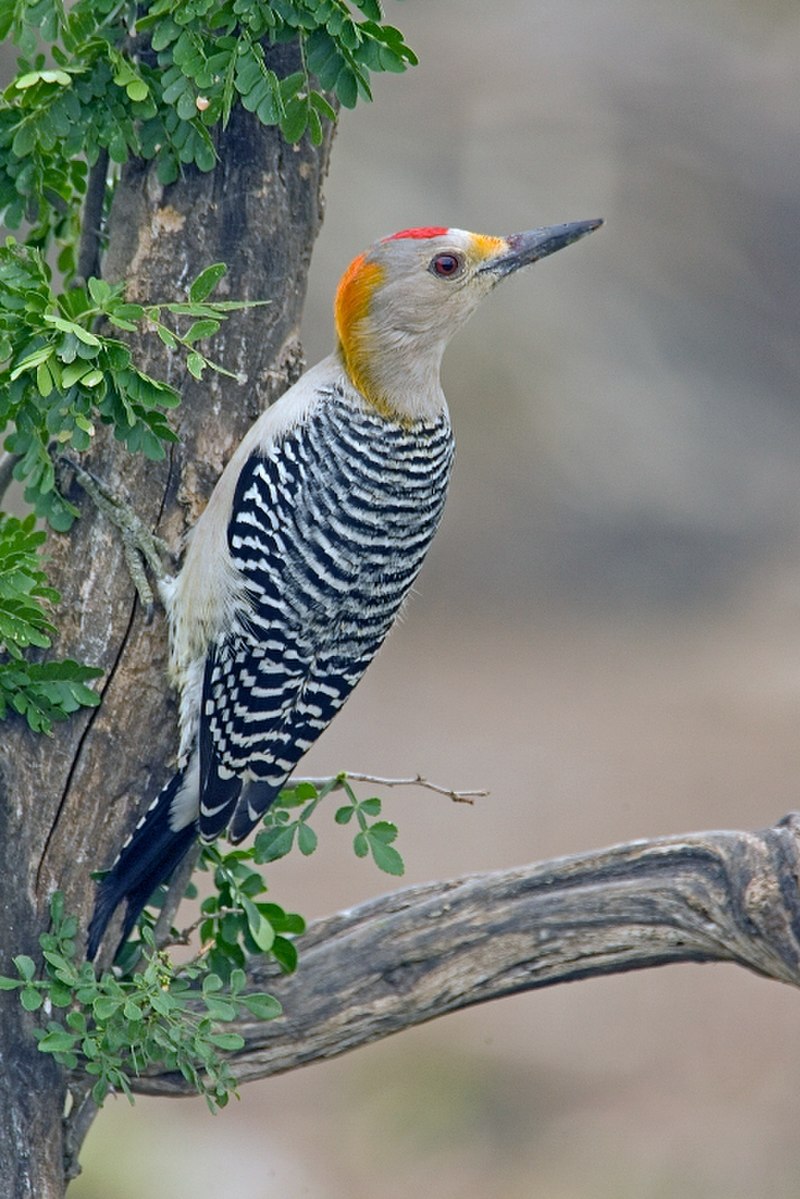
The golden-fronted woodpecker is an attractive species that inhabits mesquite, riparian woodlands and tropical rainforests across the southern United States, Mexico, Belize Guatemala El Salvador Honduras and northern Nicaragua.
It has a unique appearance with its yellow forehead patch contrasting against its grey back feathers.
These birds eat insects as well as fruits of many trees including cactus fruit in some areas.
They are known to make nests in cavities they excavate from dead or dying trees or utility poles which helps disperse essential nutrients into the ecosystem.
Their loud calls can be heard during breeding season providing bird watchers with a memorable experience.Scientific classification:
| Kingdom | Animalia |
| Phylum | Chordata |
| Class | Aves |
| Order | Piciformes |
| Family | Picidae |
| Genus | Melanerpes |
| Species | M. aurifrons |
7. Crimson-Collared Tanager
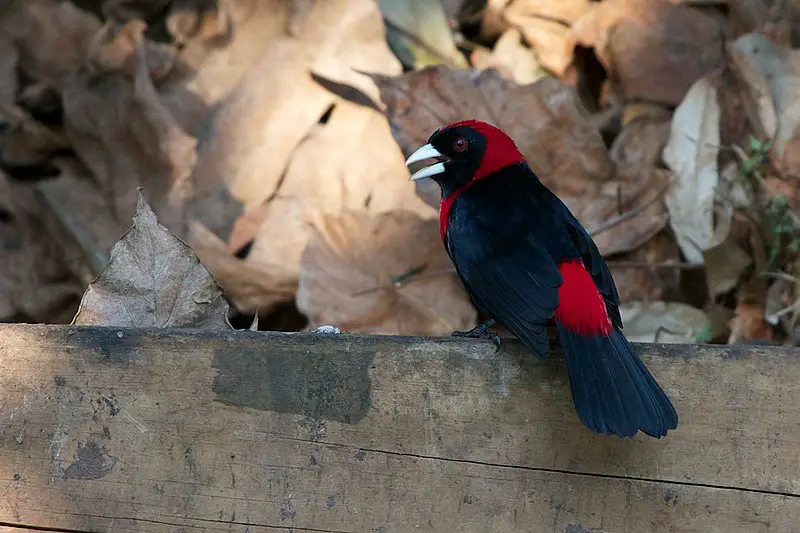
The Crimson-collared Tanager is a small songbird native to Middle America. It was first described by French naturalist René-Primevère Lesson in 1831, its specific epithet referring to the red plumage of the bird.
This species has sometimes been placed in its own genus as Phlogothraupis sanguinolenta and genetic studies suggest that it may be related to other tanagers such as blue gray or scarlet tannages.
The crimson collared tanager has predominantly black feathers on its upperparts with a distinctive bright red collar around the neck region while the underside is mostly white or pale yellowish with some faint barring present on flanks and wings.
It generally feeds off insects, fruits and berries found in trees but also scavenges for food occasionally at ground level when disturbed from their usual habitat of forests edges, scrublands and second growth woodland areas throughout Central AmericaScientific classification:
| Kingdom | Animalia |
| Phylum | Chordata |
| Class | Aves |
| Order | Passeriformes |
| Family | Thraupidae |
| Genus | Ramphocelus |
| Species | R. sanguinolentus |
8. Azure-Crowned Hummingbird
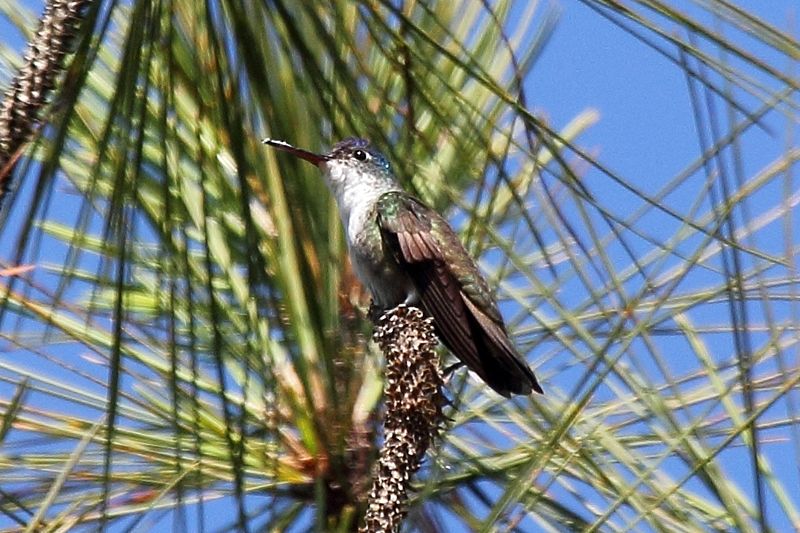
The Azure-crowned hummingbird is a species of the “emeralds” tribe Trochilini, found in Central America.
Its striking physical features include an azure crown and vibrant iridescent feathers that shimmer greenish blue when light reflects off them.
It was initially described as Ornismya cyanocephalus before being moved to its current genus Amazilia.
A molecular phylogenetic study published in 2014 showed it has close genetic ties with other emeralds such as the Green Violetear and Black-throated Mango hummers.
The bird feeds on nectar from flowers, small insects and spiders for protein, tree sap and even lizards.
This diet helps keep their metabolism high so they can stay active even during cold days or nights at higher altitudes where temperatures drop quickly after sunset.
With its beautiful colors and fascinating behavior these birds are a delight to watch wherever you may find them.Scientific classification:
| Kingdom | Animalia |
| Phylum | Chordata |
| Class | Aves |
| Order | Apodiformes |
| Family | Trochilidae |
| Genus | Saucerottia |
| Species | S. cyanocephala |
9. Pale-Billed Woodpecker
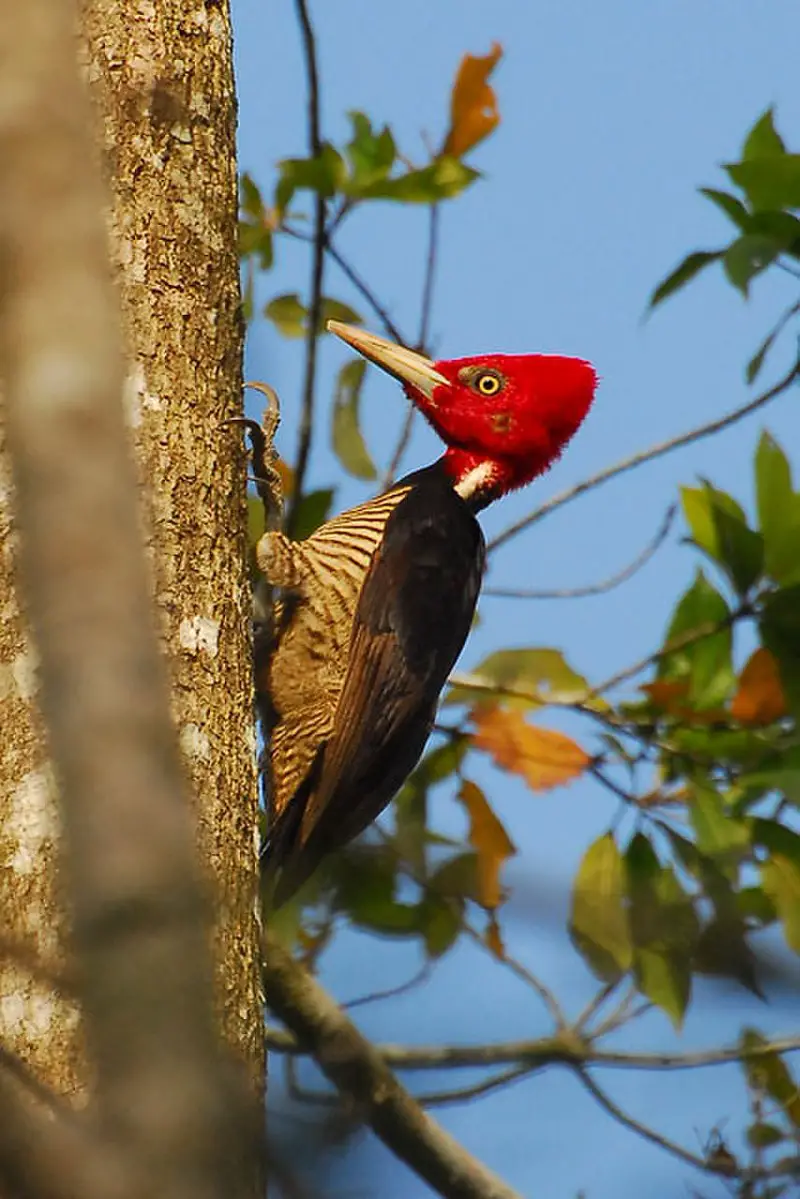
The Pale-billed woodpecker is a large, striking bird found in the tropical regions of Mexico to western Panama. It has an impressive size of 37 cm and weighs 255 g.
Its colouring consists mainly black plumage with white lines down its shoulders and a bushy crest on top. The most distinctive feature however is its pale bill which gives it its name.
This bird feeds mostly on dead or injured trees by pecking out insects from within them while they search for food in small groups or pairs. They are also known to feed on fruits, nuts, seeds and occasionally carrion too.
A truly remarkable species that adds beauty to the skies when flying around looking for their next meal.Scientific classification:
| Kingdom | Animalia |
| Phylum | Chordata |
| Class | Aves |
| Order | Piciformes |
| Family | Picidae |
| Genus | Campephilus |
| Species | C. guatemalensis |
10. Slaty-Breasted Tinamou
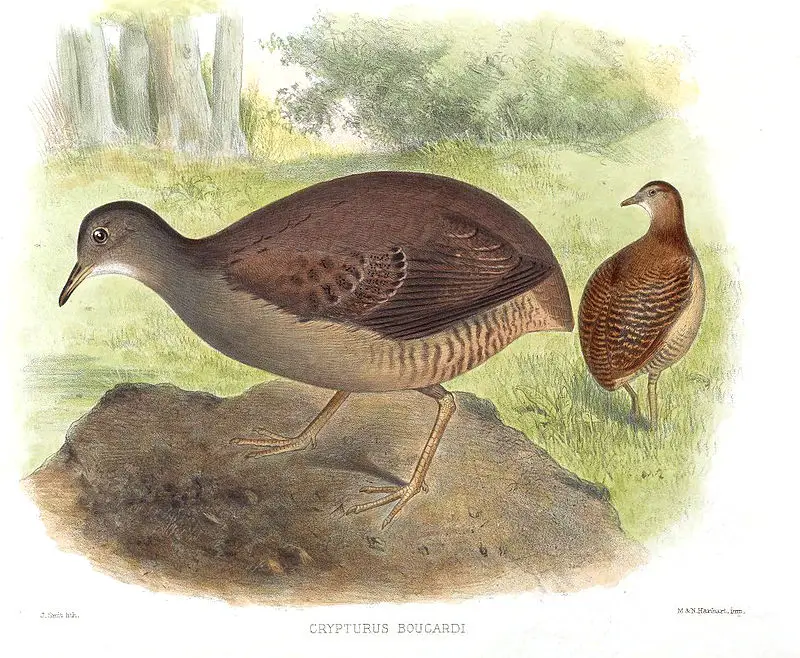
The Slaty-breasted Tinamou is a type of bird from the family Tinamidae, found in lowland moist forests of Mexico and Central America. It differs from other ratites as it can fly, though not very strongly.
This species evolved from prehistoric flying birds that lived millions of years ago, making them one of the oldest living members on earth.
They are small to medium sized birds with drab brown plumage covering most parts their body except for a pale grey breast and belly area.
These omnivorous creatures feed primarily on insects, fruits and seeds but will occasionally hunt smaller animals such as lizards or frogs too.
Generally shy around humans they make a loud ‘tok’ sound when alarmed which gives away their location easily to predators looking for an easy meal.Scientific classification:
| Kingdom | Animalia |
| Phylum | Chordata |
| Class | Aves |
| Infraclass | Palaeognathae |
| Order | Tinamiformes |
| Family | Tinamidae |
| Genus | Crypturellus |
| Species | C. boucardi |
11. Yellow-Throated Euphonia
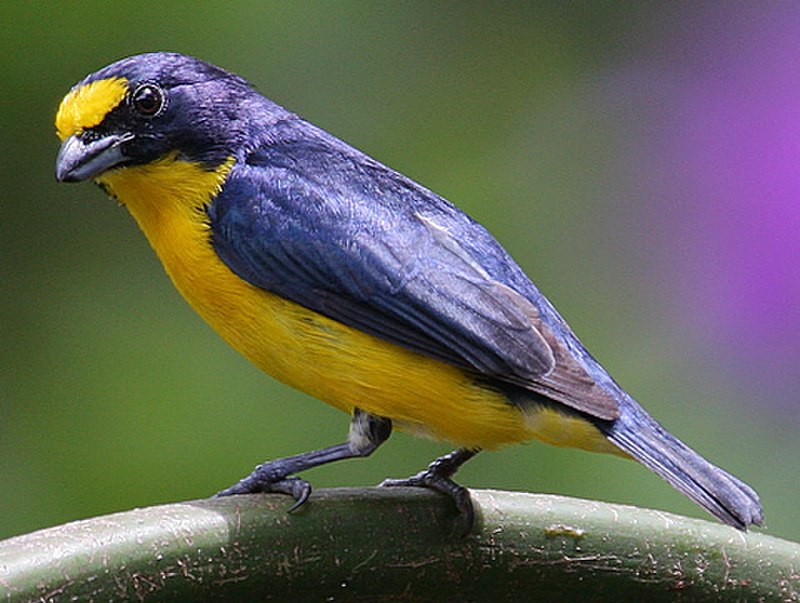
The Yellow-throated Euphonia is a species of songbird found in southeastern Mexico and throughout Central America.
It prefers to inhabit humid and dry regions, such as forest edges, open woodlands, and shaded plantations.
This charming bird has two subspecies: the nominate subspecies which resides from Belize south to western Panama; and E. hirundinacea borealis which can be found in eastern Honduras through Nicaragua into Costa Rica’s Pacific slope.
The adult males show off their bright yellow throat patch while they sing their melodic songs during mating season.
Females are typically duller but still have some yellow accents on their otherwise black head patterning or grayish underparts with dark streaking.
These birds feed mainly on insects caught among foliage or gleaned from bark crevices – making them an important part of many ecosystems across Central America.Scientific classification:
| Kingdom | Animalia |
| Phylum | Chordata |
| Class | Aves |
| Order | Passeriformes |
| Family | Fringillidae |
| Subfamily | Euphoniinae |
| Genus | Euphonia |
| Species | E. hirundinacea |
Also Featured In: Yellow Birds that Live in Yucatan,
12. Ocellated Turkey
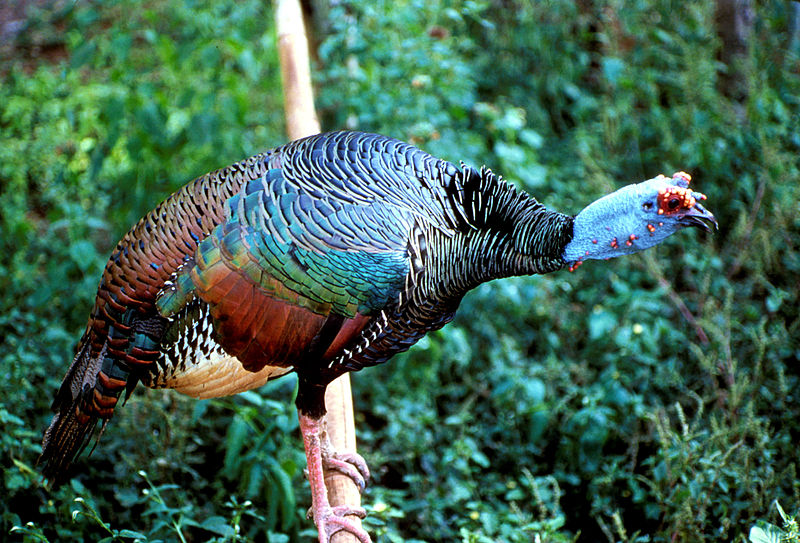
The ocellated turkey is a species of turkey found in the Yucatán Peninsula, Mexico as well as parts of Belize and Guatemala.
It is closely related to North American wild turkeys but there are slight differences between them that have led those studying these birds to keep them within separate genera.
The ocellated turkey has stunning plumage with an iridescent green head and neck, blue-green wings and tail feathers marbled with purple, bronze and gold hues.
They possess large eyespots on their tails which give this bird its name – ‘ocellate’ meaning eye or eyeball shaped spot.
These beautiful creatures typically live in forests where they feed on fruits, insects, seeds and other plant material.Scientific classification:
| Kingdom | Animalia |
| Phylum | Chordata |
| Class | Aves |
| Order | Galliformes |
| Family | Phasianidae |
| Genus | Meleagris |
| Species | M. ocellata |
13. Yucatan Amazon
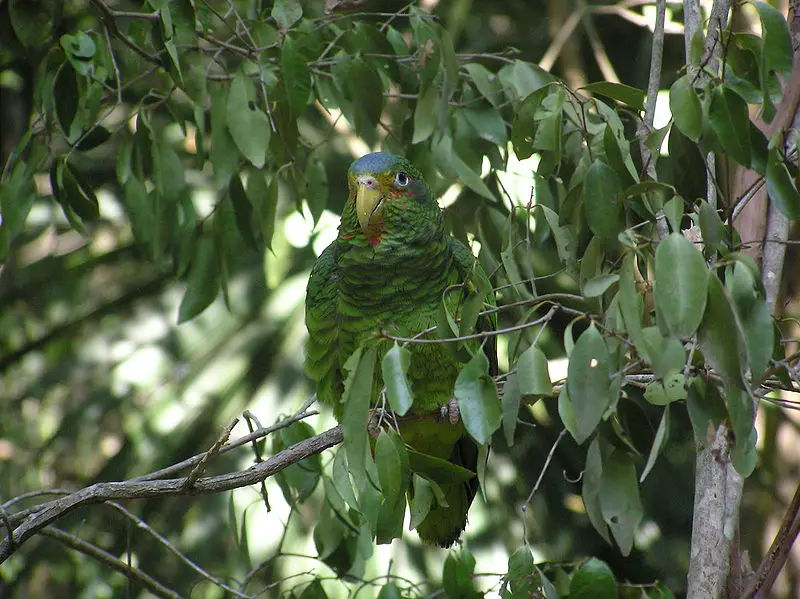
The Yucatan amazon, also known as the yellow-lored parrot is a beautiful species of Amazon Parrot native to Belize, Honduras and Mexico.
They inhabit tropical dry forests and coastal mangroves, often near heavily degraded former forest areas such as the Petenes Mangroves in Mexico.
These colorful birds boast with bright green feathers on their back, wings and tail; while their head and neck are adorned with blue feathers bordered by yellow lores.
Both males and females share these attractive markings yet they can be distinguished by size – female being slightly smaller than male counterparts.
The Yucatan Amazons have an excellent ability to mimic human speech which makes them popular pets but illegal trade also threatens its survival in wild habitats making it vulnerable for extinction if not properly protected soon enough.Scientific classification:
| Kingdom | Animalia |
| Phylum | Chordata |
| Class | Aves |
| Order | Psittaciformes |
| Family | Psittacidae |
| Genus | Amazona |
| Species | A. xantholora |
14. Rufous-Tailed Hummingbird
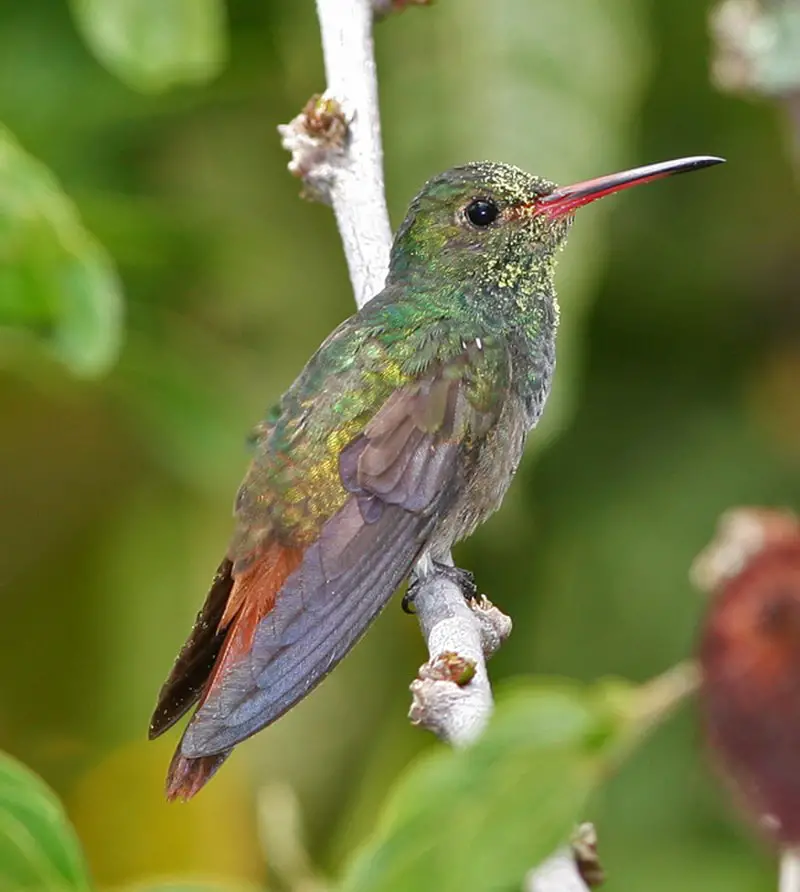
The rufous-tailed hummingbird is a medium-sized bird that belongs to the Trochilini tribe of subfamily Trochilinae. It can be found in east-central Mexico, Central America, Colombia, Ecuador and Venezuela.
This species was formally described back in 1833 by Mexican naturalist Pablo de La Llave who placed it in the genus Trochlilus and gave it its scientific name Amazilia tzacatl.
Its body has a brownish color with an orangey tail which helps distinguish it from other species.
The male’s throat also features bright blue tones on top of its light green feathers creating an eyecatching look when seen up close.
These birds feed mainly on nectar but will sometimes hunt for small insects as well; they are capable of flying at speeds reaching up to 34 mph.Scientific classification:
| Kingdom | Animalia |
| Phylum | Chordata |
| Class | Aves |
| Order | Apodiformes |
| Family | Trochilidae |
| Genus | Amazilia |
| Species | A. tzacatl |
15. White-Crowned Parrot
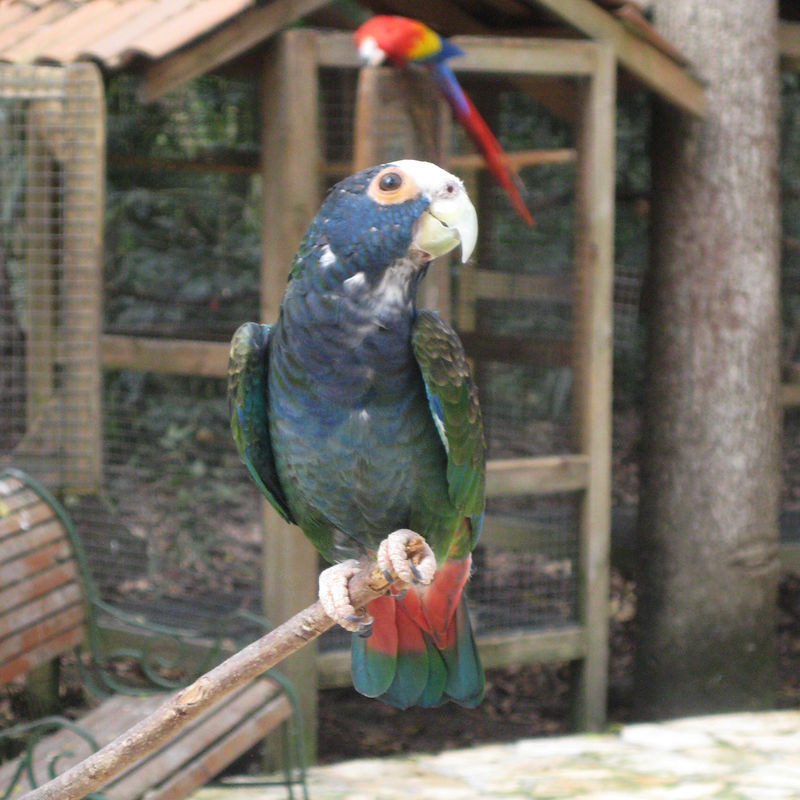
The white-crowned parrot is found in the lowlands of Mexico to western Panama. It loves living among forest canopies and edges, as well as semi-open woodland and second growth areas.
These birds have a stunning appearance with their green plumage, blue wings, and red tail feathers being topped off by a beautiful white crown on their heads.
They lay 3 to 6 eggs in an unlined nest often built within tree cavities or hollows.
The male plays an active role during mating season by helping build the nest structure while also providing food for his mate throughout incubation period of 25 days before they hatch into cute little chicks.
All in all, this species makes for a wonderful sight due to its unique colouration that truly stands out from other parrots.Scientific classification:
| Kingdom | Animalia |
| Phylum | Chordata |
| Class | Aves |
| Order | Psittaciformes |
| Family | Psittacidae |
| Genus | Pionus |
| Species | P. senilis |
16. Yucatan Woodpecker
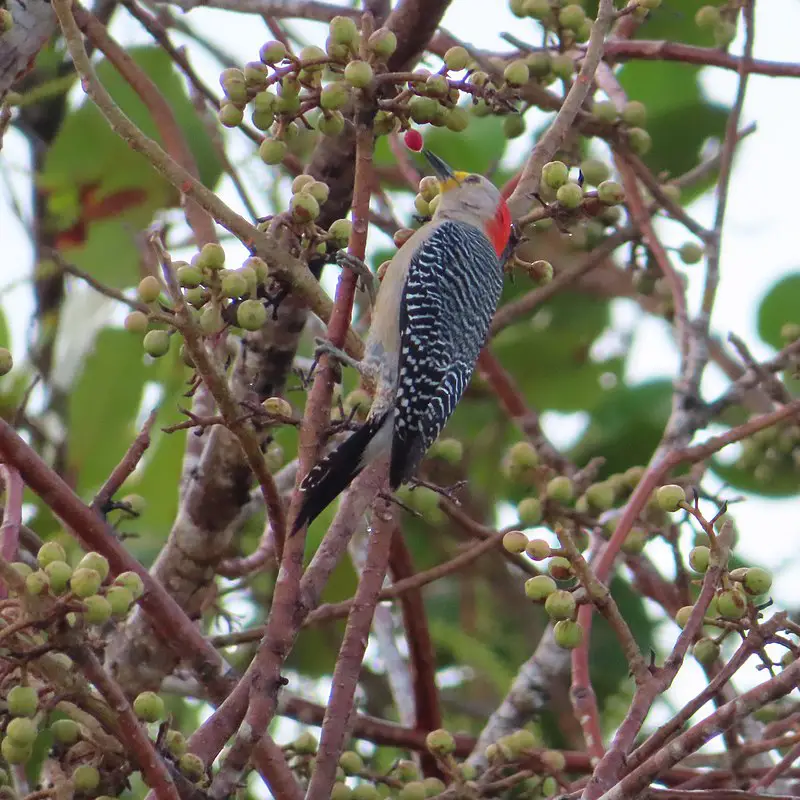
The Yucatan woodpecker is a species of bird in the family Picidae, commonly referred to as the red-vented woodpecker. It can be found from Belize and Mexico across the entire Yucatán Peninsula.
Its natural habitats are subtropical or tropical dry forests, shrubland, and even heavily degraded former forest areas.
Adults typically have a black back with white barring on both sides of their wings; they also possess a distinctive crimson patch at their lower belly area which gives them their “red-vented” name.
They mainly feed off insects that inhabit dead trees but may also eat fruits during different times of year when available.
The Yucatan Woodpecker has an important role in its ecosystem by helping disperse seeds through propagating fruit plants while searching for food sources within tree trunks – this helps maintain healthy populations of native vegetation throughout its range.Scientific classification:
| Kingdom | Animalia |
| Phylum | Chordata |
| Class | Aves |
| Order | Piciformes |
| Family | Picidae |
| Genus | Melanerpes |
| Species | M. pygmaeus |
17. Red-Capped Manakin
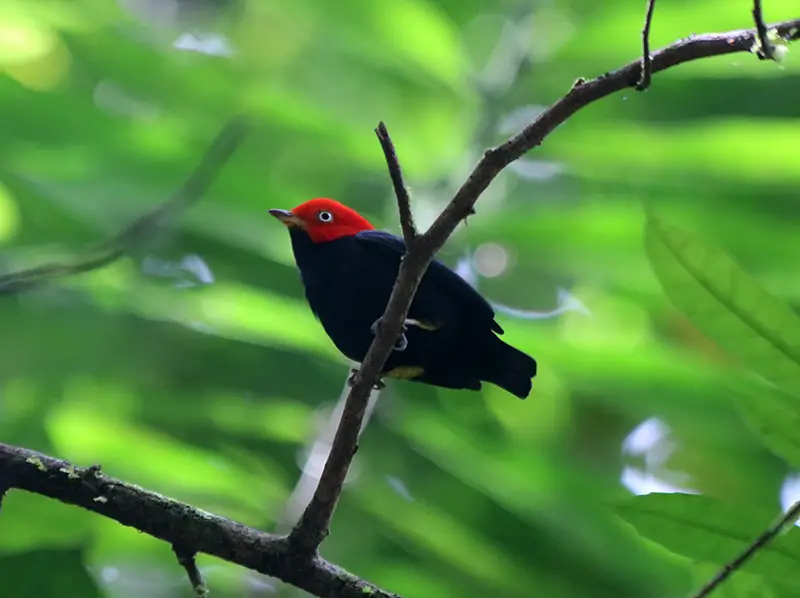
The red-capped manakin is a species of bird found in Central and South America. It has distinctive red feathers on its head that contrast with the otherwise dark plumage, giving it an unmistakable appearance.
The male is particularly noteworthy for his courtship display, which involves rapidly shuffling backwards along a branch while making loud calls to attract potential mates.
This behaviour makes them highly sought after by birdwatchers who come from far and wide to observe this unique ritual.
In addition to their fascinating courtship behavior, they are also important seed dispersers throughout their range which helps maintain healthy ecosystems in these areas.
Despite being relatively common across much of its range, habitat loss due to deforestation has left some populations vulnerable and conservation efforts need continued attention if we want future generations of people have the chance to witness these remarkable birds performing their captivating dance displays.Scientific classification:
| Kingdom | Animalia |
| Phylum | Chordata |
| Class | Aves |
| Order | Passeriformes |
| Family | Pipridae |
| Genus | Ceratopipra |
| Species | C. mentalis |
18. Long-Billed Hermit
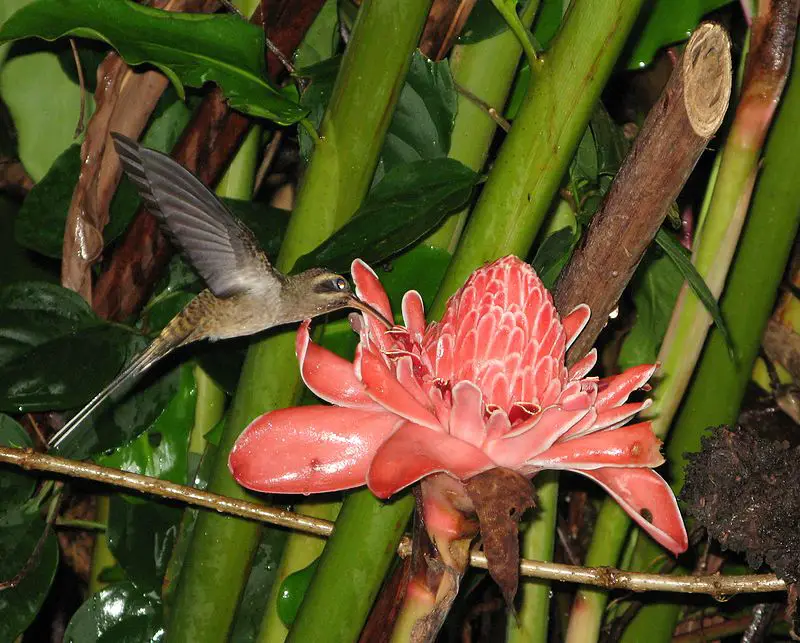
The Long-billed hermit is a beautiful hummingbird belonging to the Trochilidae family. It can be found from central Mexico all the way south to Colombia, Ecuador and Peru.
This bird has often been confused with its eastern counterpart known as The long-tailed hermit which are mainly seen east of Andes mountain range.
Long-billed Hermit birds have slender bodies and long bills that help them in easily reaching nectar at flowers deep within their corollas for feeding purposes.
They also feed on insects like spiders, beetles, wasps etc., during summers when flower production decreases significantly.
These birds usually make nests out of plant fibers held together by spider webs near stream banks or humid forests where they lay one or two white eggs per nest cycle making it an important part of ecology in South American regionsScientific classification:
| Kingdom | Animalia |
| Phylum | Chordata |
| Class | Aves |
| Order | Apodiformes |
| Family | Trochilidae |
| Genus | Phaethornis |
| Species | P. longirostris |
19. Purple-Crowned Fairy
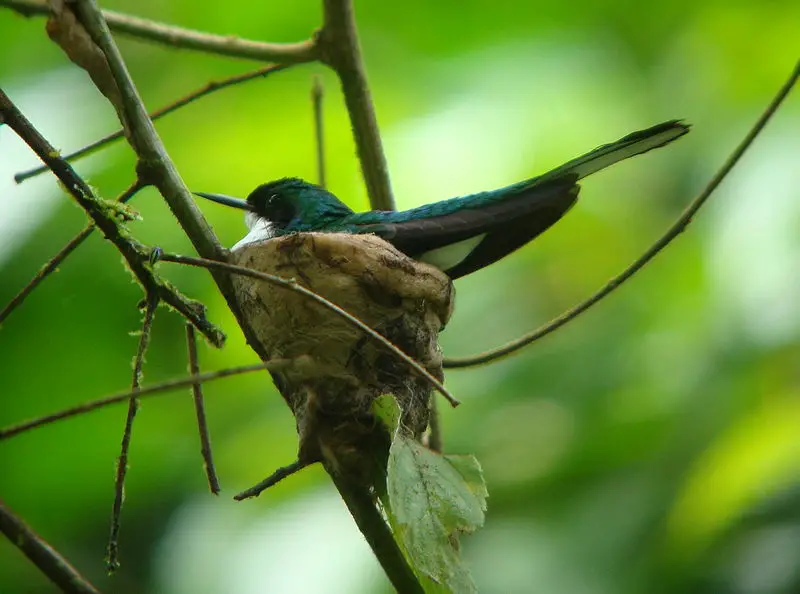
The Purple-crowned fairy is a beautiful species of hummingbird that can be found in southeastern Mexico and northern Peru. It has an unmistakable purple crown, which gives it its name.
The wings are iridescent green and the tail feathers have white tips. This bird feeds primarily on nectar from flowers, but will also eat small insects to supplement their diet.
They are very territorial during mating season and males will often display aggressive behavior towards other males while defending territory or attempting to attract mates.
These birds live mainly in woodlands at elevations between 1,000 – 2,500 m (3281– 8202 ft). Their populations have seen a decrease recently due to destruction of habitat by humans as well as competition with invasive species for resources such as food and nesting sites within their range.Scientific classification:
| Kingdom | Animalia |
| Phylum | Chordata |
| Class | Aves |
| Order | Apodiformes |
| Family | Trochilidae |
| Genus | Heliothryx |
| Species | H. barroti |
20. Thicket Tinamou
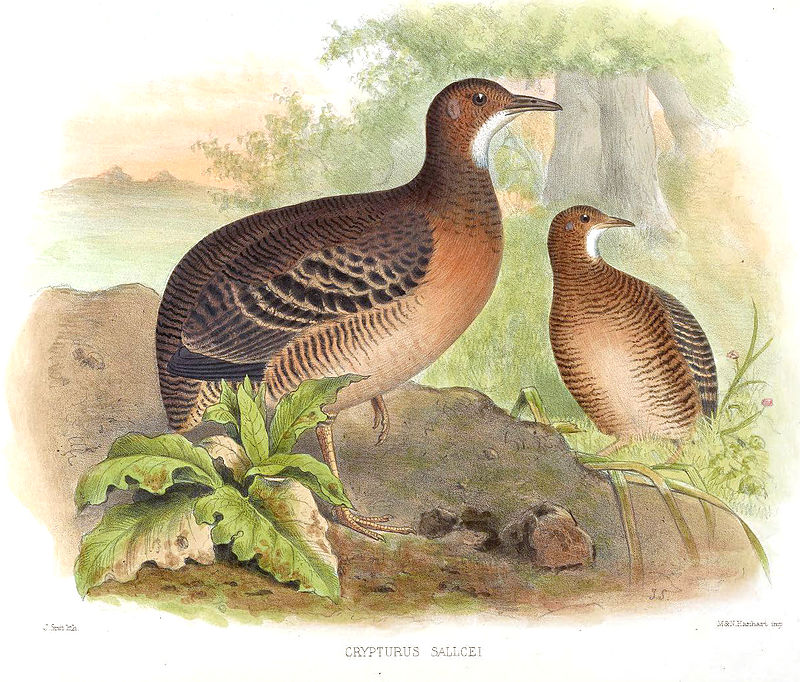
The Thicket tinamou is a type of bird found in moist forests of Central Mexico. It belongs to the family Tinamidae and is classified as a ratite, which are flightless birds that evolved from prehistoric flying species.
Despite its lack of strong flying abilities, this small brownish-grey bird can fly short distances and usually hops around on the ground instead.
Their diet consists mainly of fruits, seeds, insects and other invertebrates they find while foraging through vegetation or even grazing at times during dry season when food sources become scarce.
These solitary birds typically form pairs only during mating season where both parents work together to incubate eggs until hatchlings emerge into the world.Scientific classification:
| Kingdom | Animalia |
| Phylum | Chordata |
| Class | Aves |
| Infraclass | Palaeognathae |
| Order | Tinamiformes |
| Family | Tinamidae |
| Genus | Crypturellus |
| Species | C. cinnamomeus |
Also Featured In: Birds that You’ll Find in Chiapas, Most Common Birds Found in Nayarit
21. Middle American Screech Owl
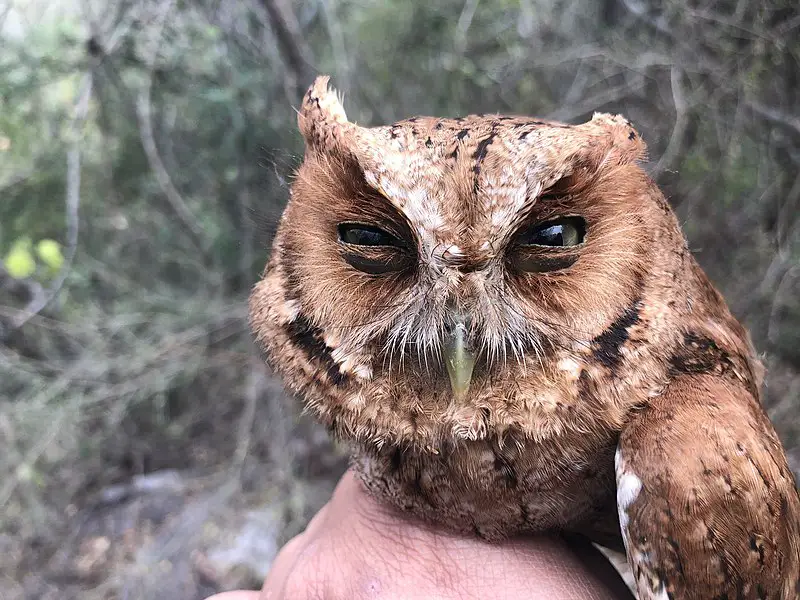
The Middle American screech owl (Megascops guatemalae) is a species of owl found in North America and northern Nicaragua. It has an average length of 18-20 cm, with short wings and tail feathers.
They are usually grey or brownish but can be more colourful depending on their subspecies. Despite its small size it is capable of making loud vocalizations including hoots and screams which it uses to communicate with other owls as well as for defense against predators like hawks, eagles, foxes and cats.
The International Ornithological Committee recognizes five different subspecies: fuscus, dacrysistactus, griseotectus melanophris etruscus; each one having slight variations in plumage colouration from dark browns to lighter greys.
This beautiful bird provides us with hours of entertainment during the night while keeping pests at bay.Scientific classification:
| Kingdom | Animalia |
| Phylum | Chordata |
| Class | Aves |
| Order | Strigiformes |
| Family | Strigidae |
| Genus | Megascops |
| Species | M. guatemalae |
22. Chestnut-Colored Woodpecker
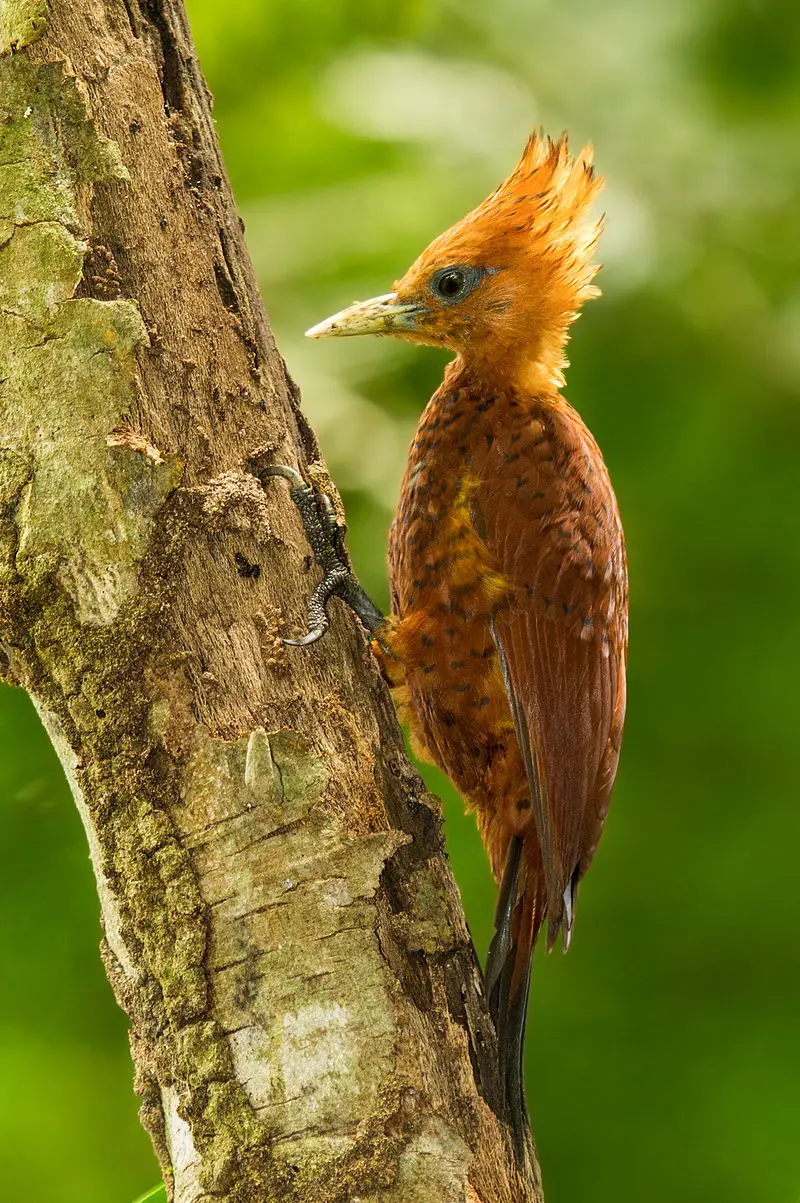
The Chestnut-colored woodpecker is a stunning bird found in Central America. It has an unmistakable rich chestnut color, with intricate V-shaped black markings on its back and wings.
Its head is creamy brown, topped with a crest of feathers and it’s bill has a greenish ivory hue to it. The male also sports broader moustache stripes than the female counterpart, making them easy to tell apart.
This species can be found inhabiting subtropical or tropical moist lowland forests and primarily feeds off insects such as ants, beetles etc., which they capture by drumming rapidly on dead branches or tree trunks using their long bills.
They are very territorial birds but will occasionally flock together when food sources become scarce during dry weather spells .Scientific classification:
| Kingdom | Animalia |
| Phylum | Chordata |
| Class | Aves |
| Order | Piciformes |
| Family | Picidae |
| Genus | Celeus |
| Species | C. castaneus |
23. Golden-Olive Woodpecker
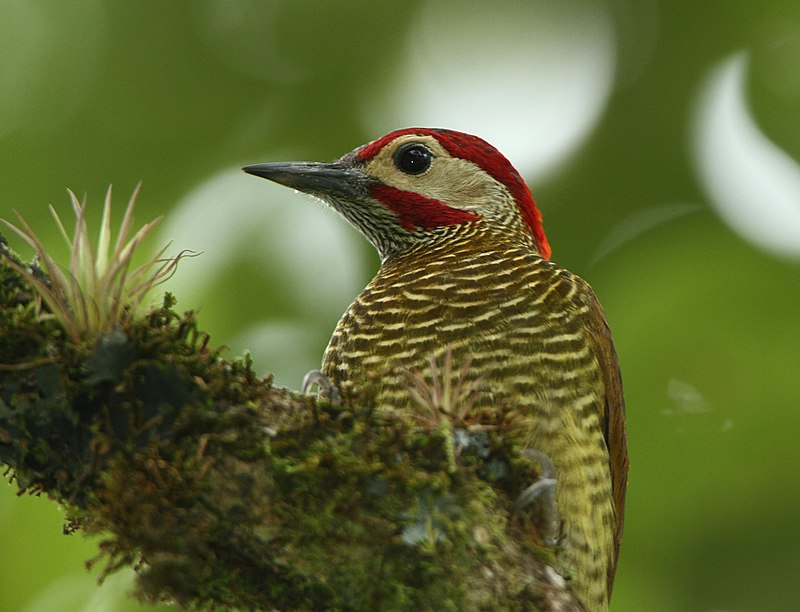
The Golden-olive Woodpecker is a colorful bird native to Mexico, Guyana, Argentina and Trinidad & Tobago. It can be recognized by its rust-colored wings and back as well as its bright yellow throat.
This species of woodpecker measures about 20 cm in length with an average weight between 25 – 36 grams. Its diet consists mainly of insects but it also feeds on fruits such as figs or berries when available.
The birds usually make their nests in tree cavities where they lay two to five eggs at once which are incubated for 11–14 days before hatching.
These woodpeckers have been observed living up to 8 years old in the wild making them quite long lived compared to many other species.Scientific classification:
| Kingdom | Animalia |
| Phylum | Chordata |
| Class | Aves |
| Order | Piciformes |
| Family | Picidae |
| Genus | Colaptes |
| Species | C. rubiginosus |
24. Brown-Hooded Parrot
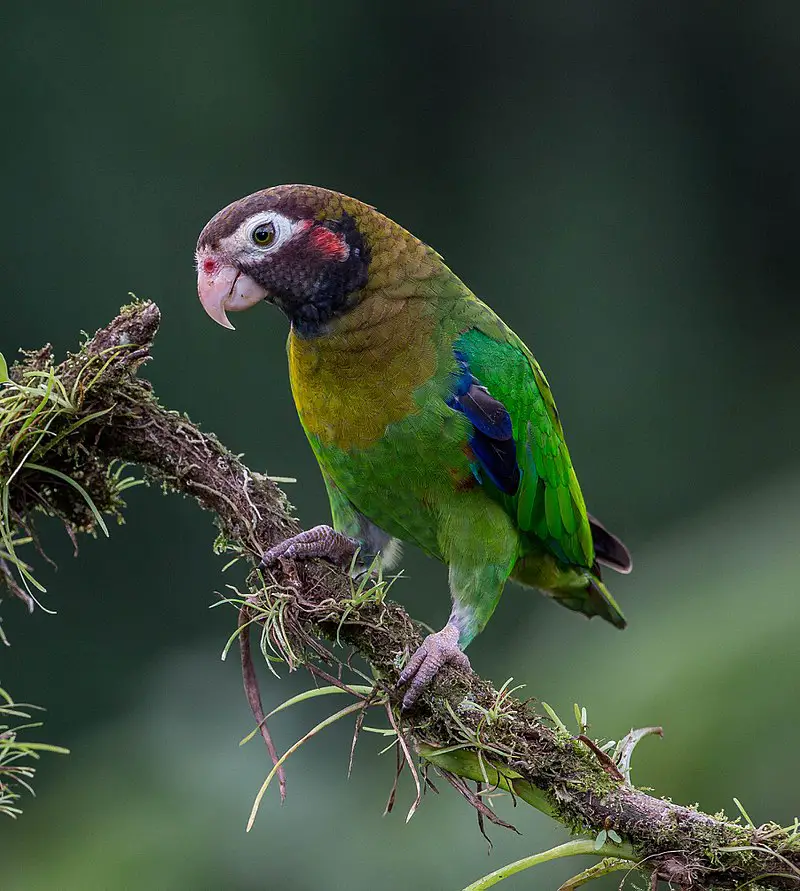
The Brown-hooded Parrot is a colorful small parrot that is native to southeastern Mexico, through Central America and into northwestern Colombia.
It was formerly placed in the genus Pionopsitta with its close relatives, but now has its own distinct classification.
This species of parrots have been heavily impacted by deforestation due to human activity as well as capture for pet trade demand.
They typically live near humid lowland forest areas where they feed on fruits, flowers, leaves and buds of trees like palm or figs.
The male bird usually has an olive green back while the female’s upperparts are greyish brown with pink cheeks and black crown feathers giving it a unique look among other birds in their range.
With conservation efforts being put forward these beautiful birds can hopefully be saved from further habitat destruction so future generations may enjoy them.Scientific classification:
| Kingdom | Animalia |
| Phylum | Chordata |
| Class | Aves |
| Order | Psittaciformes |
| Family | Psittacidae |
| Genus | Pyrilia |
| Species | P. haematotis |
25. Rusty Sparrow
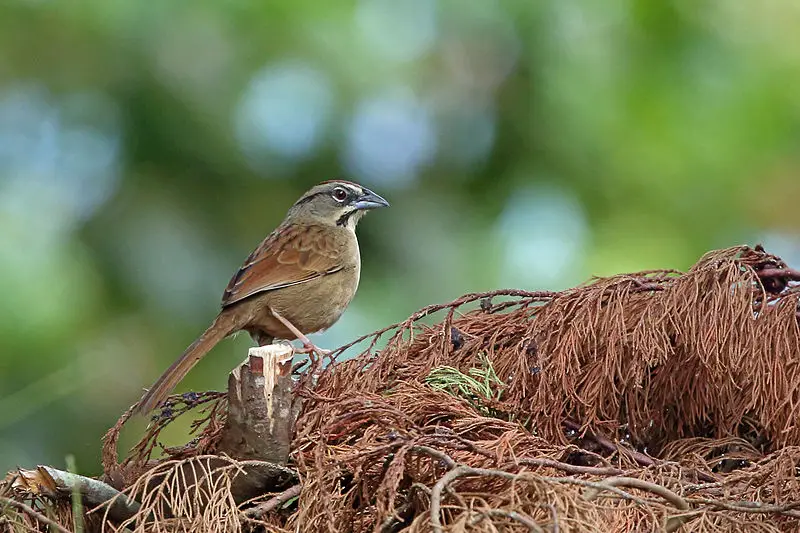
The Rusty Sparrow is a beautiful species of bird found in Central America, from Belize to Nicaragua.
It inhabits subtropical or tropical dry forests, moist montane forests and high-altitude shrublands.
Its plumage is brownish gray with rusty margins on the feathers that give it its distinctive name.
The male has an eye ring and moustache stripe which are both white while females have only one whitish streak above their eyes but lack other distinguishing features.
These birds feed mostly on insects such as beetles and ants by foraging among tree foliage or hunting them at ground level.
They also consume small fruits like figs which provide essential moisture during dry periods when there’s little water available for drinking purposes.
Despite its attractive coloring and interesting behavior, this species faces habitat loss due to deforestation activities as well as predation by larger animals so conservation efforts should be made to ensure these wonderful creatures don’t become extinct in our lifetime.Scientific classification:
| Kingdom | Animalia |
| Phylum | Chordata |
| Class | Aves |
| Order | Passeriformes |
| Family | Passerellidae |
| Genus | Aimophila |
| Species | A. rufescens |
26. Green Jay
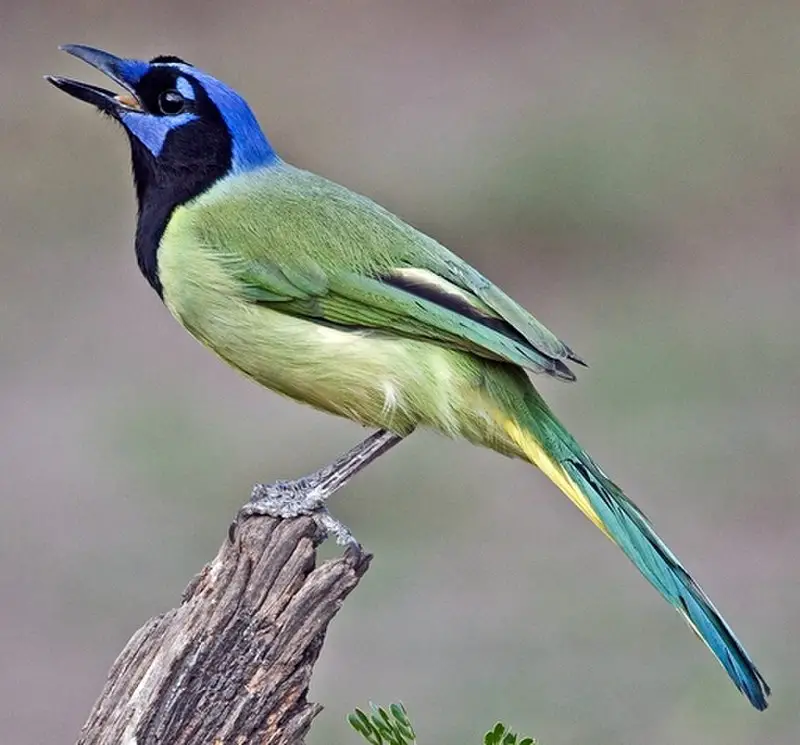
The green jay is a beautiful bird that can be found in Central America. It has blue and black heads, with green wings, mantle and tail. The bill is black while the eye rings are yellow or brown.
Its legs are dark coloured and it measures 27 cm in length. Their diet consists of arthropods, vertebrates, seeds and fruit which provide them with essential nutrients for their survival.
They have adapted to many different habitats like forests, fields and gardens where they live peacefully alongside other birds species until humans interfere with their environment by cutting down trees or polluting water sources amongst others activities that disrupts nature’s balance thus affecting these amazing creatures negatively.Scientific classification:
| Kingdom | Animalia |
| Phylum | Chordata |
| Class | Aves |
| Order | Passeriformes |
| Family | Corvidae |
| Genus | Cyanocorax |
| Species | C. luxuosus |
Also Featured In: Birds You’ll Find in South Texas , Birds You’ll Find in the Rio Grande Valley
27. Thick-Billed Seed Finch
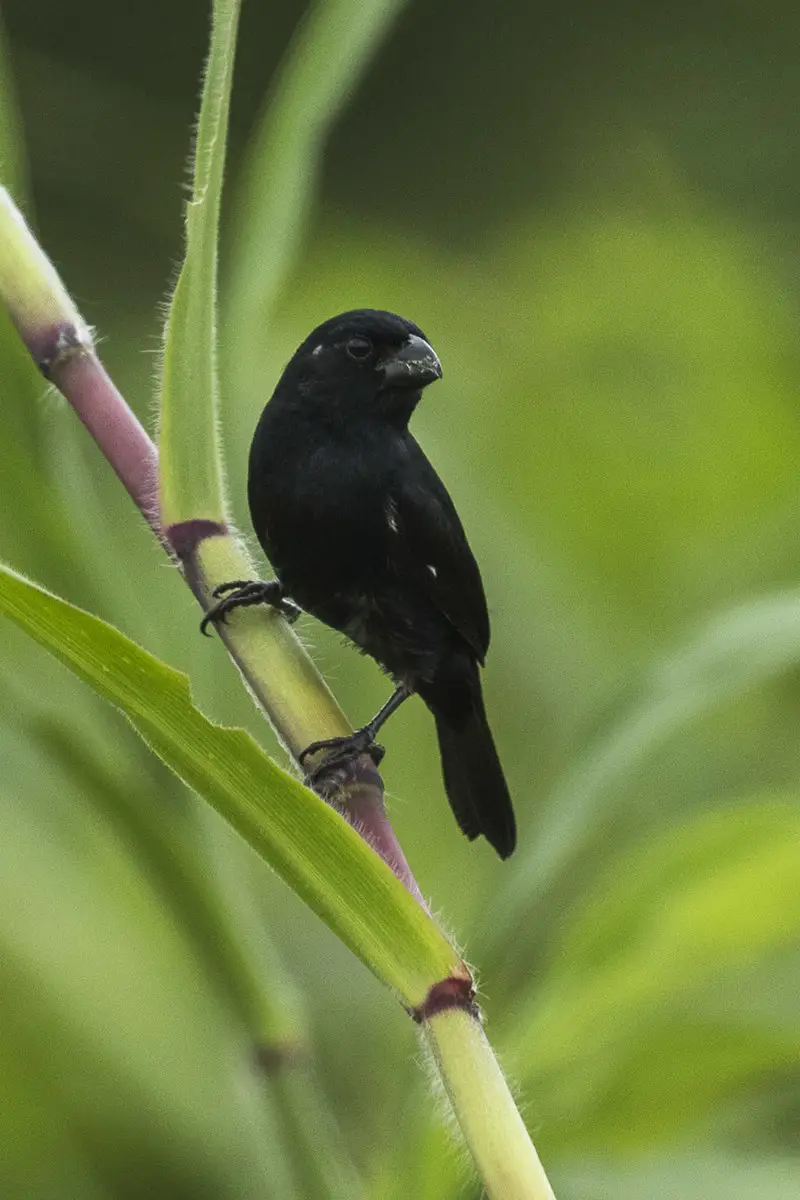
The Thick-billed Seed Finch is a small species of bird that has been recently reclassified as part of the Thraupidae family.
It inhabits shrubby and grassy areas from southern Mexico to Colombia and Ecuador, but can also be found in some parts of South America east of the Andes.
This little finch generally measures 12 cm long with a wingspan ranging between 16–18 cm.
Its plumage usually consists of grayish brown or black upperparts, whitish underparts, white throat patch and red malar stripe extending towards its chin area.
The bill is thickened at the base which helps distinguish it among other birds on location.
They feed mainly on seeds taken directly off plants although they will take insects occasionally too if available. These birds form loose flocks while foraging so they are quite social creatures when out hunting food together.Scientific classification:
| Kingdom | Animalia |
| Phylum | Chordata |
| Class | Aves |
| Order | Passeriformes |
| Family | Thraupidae |
| Genus | Sporophila |
| Species | S. funerea |
28. Couch’s Kingbird
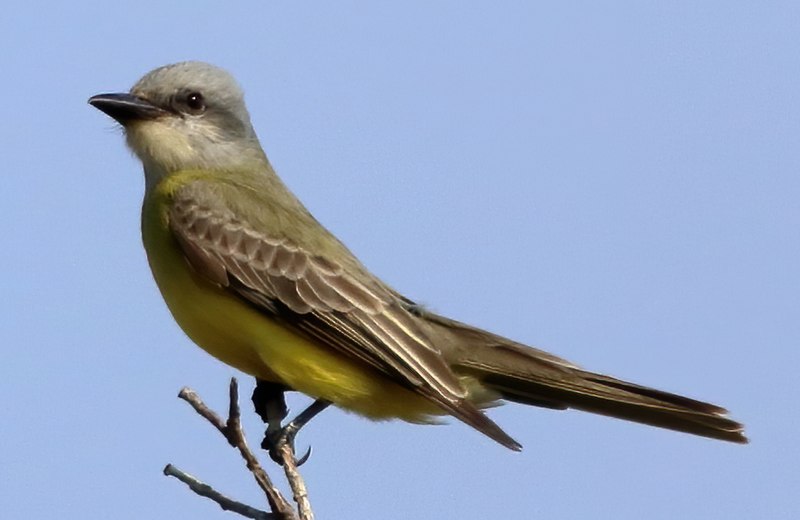
Couch’s kingbird is a passerine tyrant flycatcher found along the Gulf Coast, Yucatán Peninsula, Mexico and northern Guatemala. Named after soldier and naturalist Darius N.
Couch, this bird measures about 7 inches long with an olive green back and yellowish underside.
It has a white throat with dark streaks on its head while also having two bold white wing bars that are visible in flight.
The tail of this species is black tipped with whitish edges which helps it to be easily identified among other birds of similar size.
Its diet mainly consists of insects as well as berries during migration season when invertebrates become scarce in its habitat areas making it quite adaptive for survival purposes.Scientific classification:
| Kingdom | Animalia |
| Phylum | Chordata |
| Class | Aves |
| Order | Passeriformes |
| Family | Tyrannidae |
| Genus | Tyrannus |
| Species | T. couchii |
Also Featured In: Common San Antonio Birds, Yellow Birds You’ll Find in Michigan
29. Keel-Billed Motmot
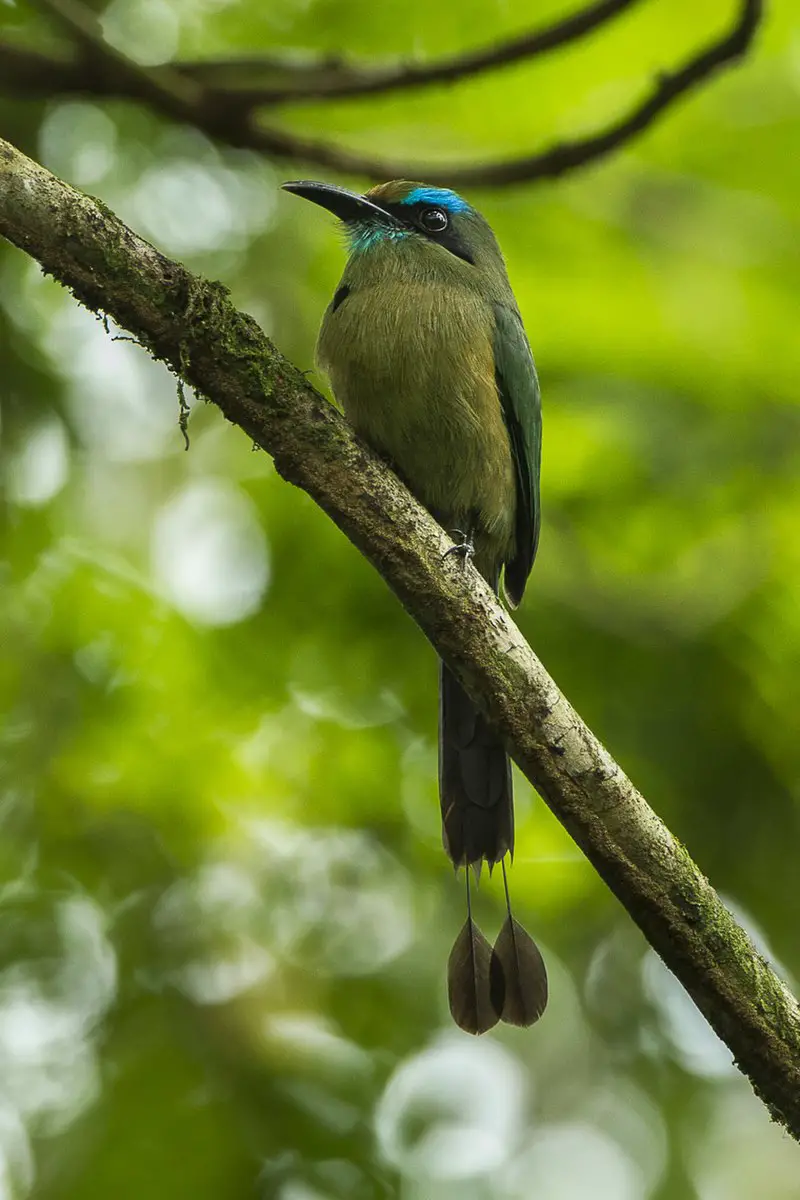
The keel-billed motmot is a species of bird belonging to the Momotidae family, closely related to its cousin the broad-billed motmot.
It has a distinct plumage and can be found in Belize, Costa Rica, Guatemala, Honduras, Nicaragua and Mexico.
This medium sized bird typically measures up to 30 cm long with distinctive colors ranging from greenish blue above and yellow below with black streaks on wings while having bright orange red bill with black tip featuring unique ‘keeled’ appearance that gives this species its name.
The call of these birds are generally loud whistles made out of two notes which differentiate it from other Motmots.
They mostly feed on insects such as ants or beetles alongwith fruits like berries or small lizards and frogs occasionally when available.
These colorful birds inhabit tropical forests making them an interesting sight for tourists visiting different places in Central America where they live..Scientific classification:
| Kingdom | Animalia |
| Phylum | Chordata |
| Class | Aves |
| Order | Coraciiformes |
| Family | Momotidae |
| Genus | Electron |
| Species | E. carinatum |
30. Pinnated Bittern
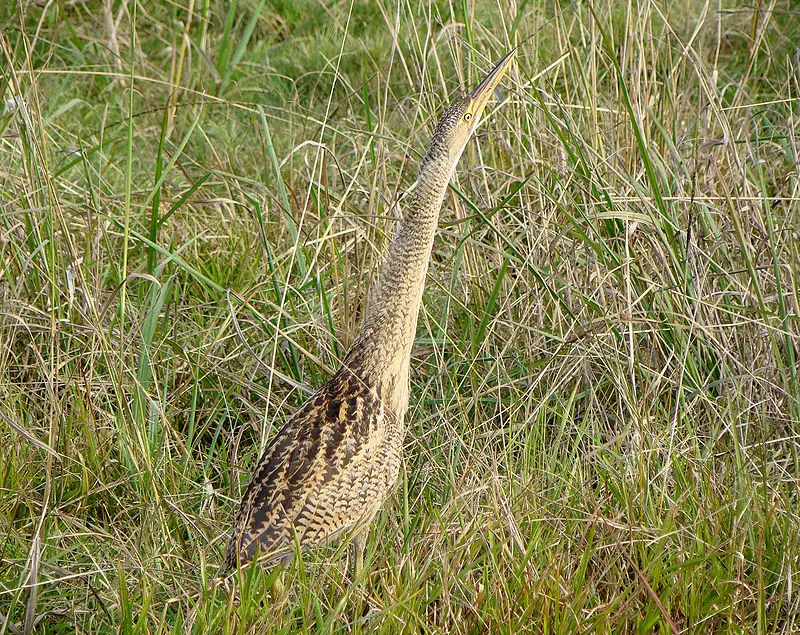
The Pinnated Bittern is a large member of the heron family, found in tropical New World regions. It’s mostly buffy-brown and cryptically patterned with an elusive nature that makes it rarely seen.
Its habitat consists of shallow wetlands including marshes, swamps and lake shores where it feeds on amphibians, reptiles and insects such as dragonflies.
The species can become quite vocal during breeding season which includes various low growls emitted from its hiding spot amongst reeds or tall grasses to attract mates or warn intruders.
Despite being widespread, there still remains much unknown about this secretive bird due to difficulty studying them in their natural environment making conservation efforts challenging yet essential for the future survival of this unique species.Scientific classification:
| Kingdom | Animalia |
| Phylum | Chordata |
| Class | Aves |
| Order | Pelecaniformes |
| Family | Ardeidae |
| Genus | Botaurus |
| Species | B. pinnatus |
31. White-Crowned Pigeon
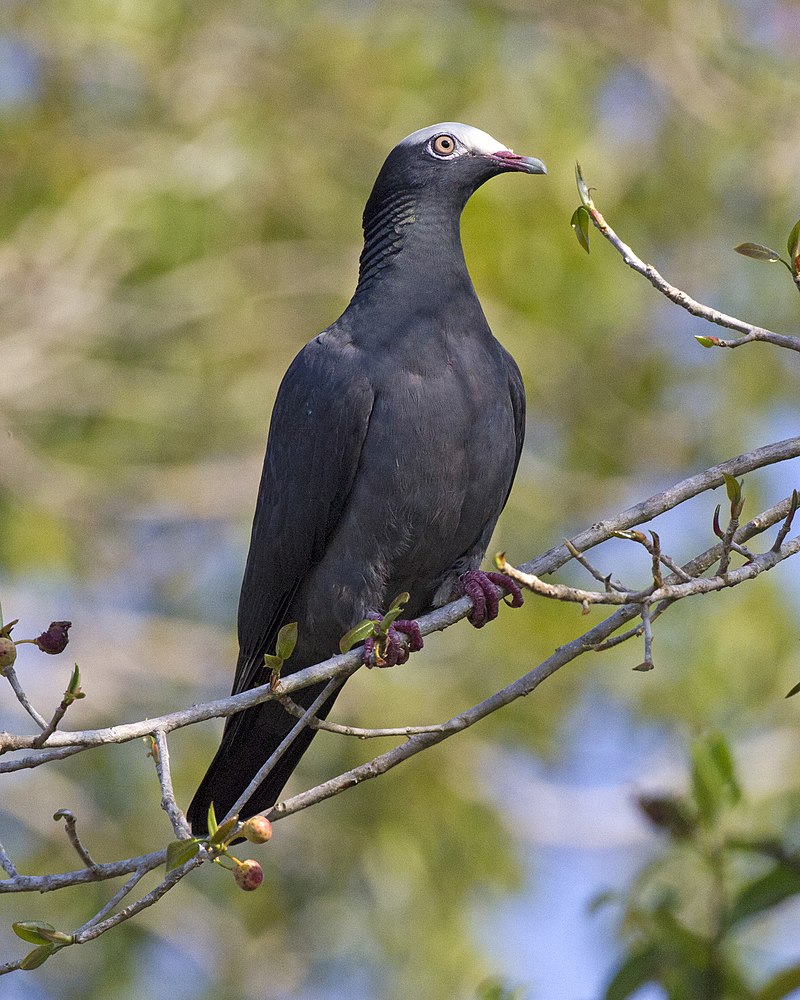
The White-crowned Pigeon is a species of bird belonging to the Columbidae family, widely found in the Caribbean. In the first half of the 18th century it was described as such.
This pigeon has been immortalized by artist John James Audubon through his watercolor painting featured in Birds of America published during early 19th century.
These birds primarily feed on fruits and seeds and have white crowns that make them easily recognizable even from afar.
The beauty of these birds makes them popular amongst birdwatchers all over the world who flock to observe their behavior while they eat or nest.Scientific classification:
| Kingdom | Animalia |
| Phylum | Chordata |
| Class | Aves |
| Order | Columbiformes |
| Family | Columbidae |
| Genus | Patagioenas |
| Species | P. leucocephala |
Also Featured In: Winged Marvels of St Martin’s: A Bird Enthusiast’s Delight, Birds That Live around Grand Turk Island
32. White-Necked Puffbird
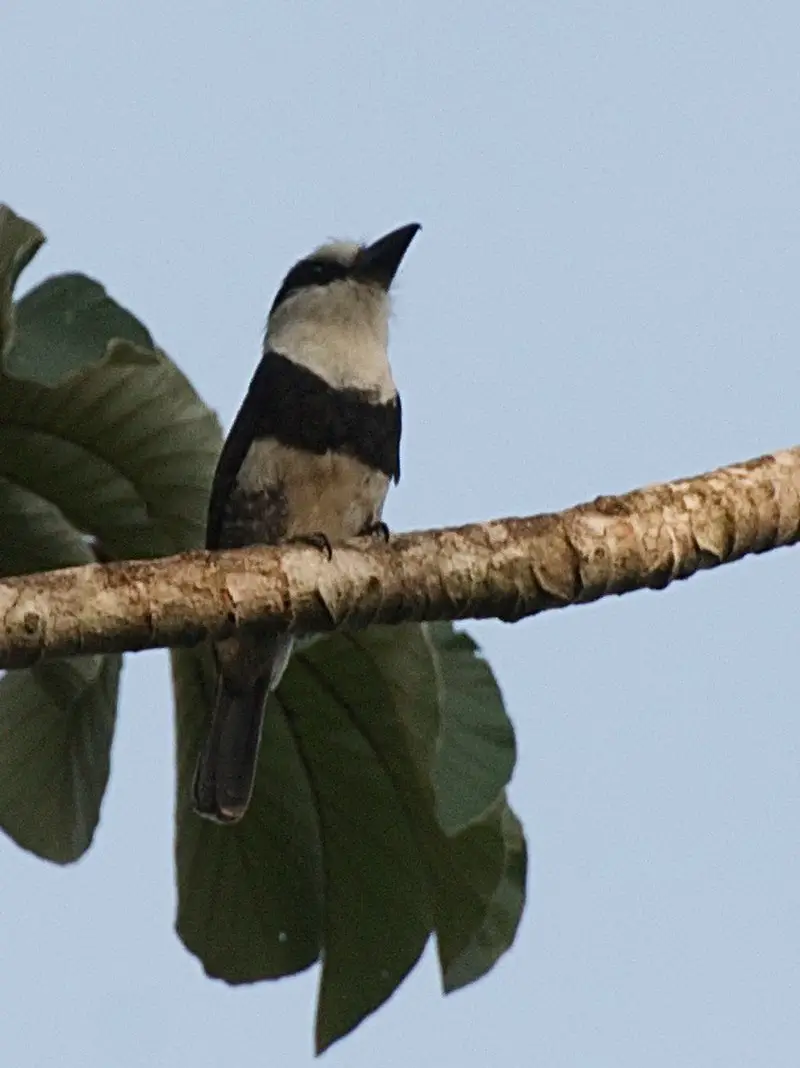
The White-necked Puffbird is a species of bird belonging to the Bucconidae family, found in Mexico, Central America, Bolivia and various other parts of South America.
It has white feathers on its neck which distinguishes it from the Buff-bellied Puffbird and Guianan Puffbird. It can also be identified by its large bill with hooked tip and prominent yellow eyes.
The adult plumage consists largely of greyish brown upperparts fading into pale buff underparts while juveniles are much duller than adults.
These birds prefer tropical lowland forests where they roost in trees or bushes before flying out occasionally during the day to feed on insects such as beetles, grasshoppers and caterpillars that they catch using their long bills.
They make loud calls consisting mostly of whistles though may also utter more complex vocalizations including mimicry at times too.Scientific classification:
| Kingdom | Animalia |
| Phylum | Chordata |
| Class | Aves |
| Order | Piciformes |
| Family | Bucconidae |
| Genus | Notharchus |
| Species | N. hyperrhynchus |
33. White-Bellied Emerald
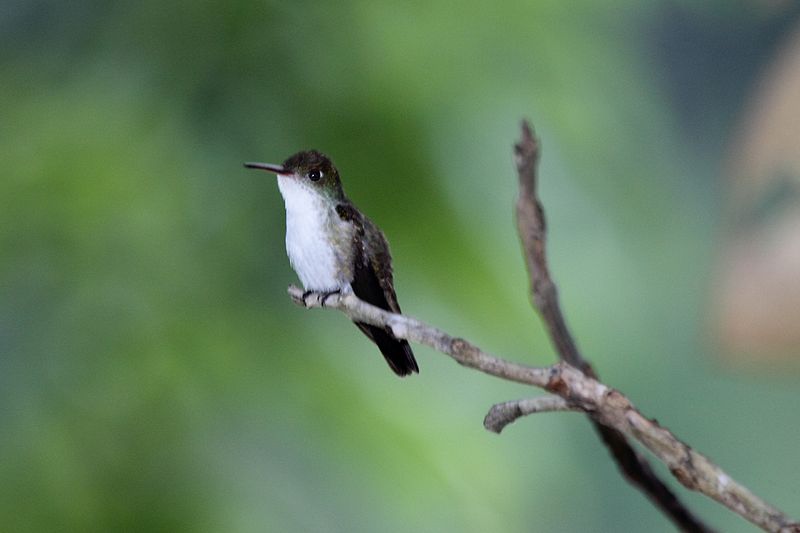
The White-bellied Emerald is a species of hummingbird found in Central American countries such as Belize, Guatemala, Honduras, Mexico and Nicaragua.
This small bird has an emerald green body with white bellies which makes it stand out in its natural habitat.
It was originally classified under the genus Amazilia but following a molecular phylogenetic study published in 2014 it was discovered that this genus is polyphyletic so now belongs to Chlorestes candida instead.
The White-bellied Emerald may not be the biggest or most colorful of birds but due to its unique markings and charming personality you can’t help admire it when seen flying gracefully through forests or meadows near riversides.Scientific classification:
| Kingdom | Animalia |
| Phylum | Chordata |
| Class | Aves |
| Order | Apodiformes |
| Family | Trochilidae |
| Genus | Chlorestes |
| Species | C. candida |
34. Black Hawk-Eagle
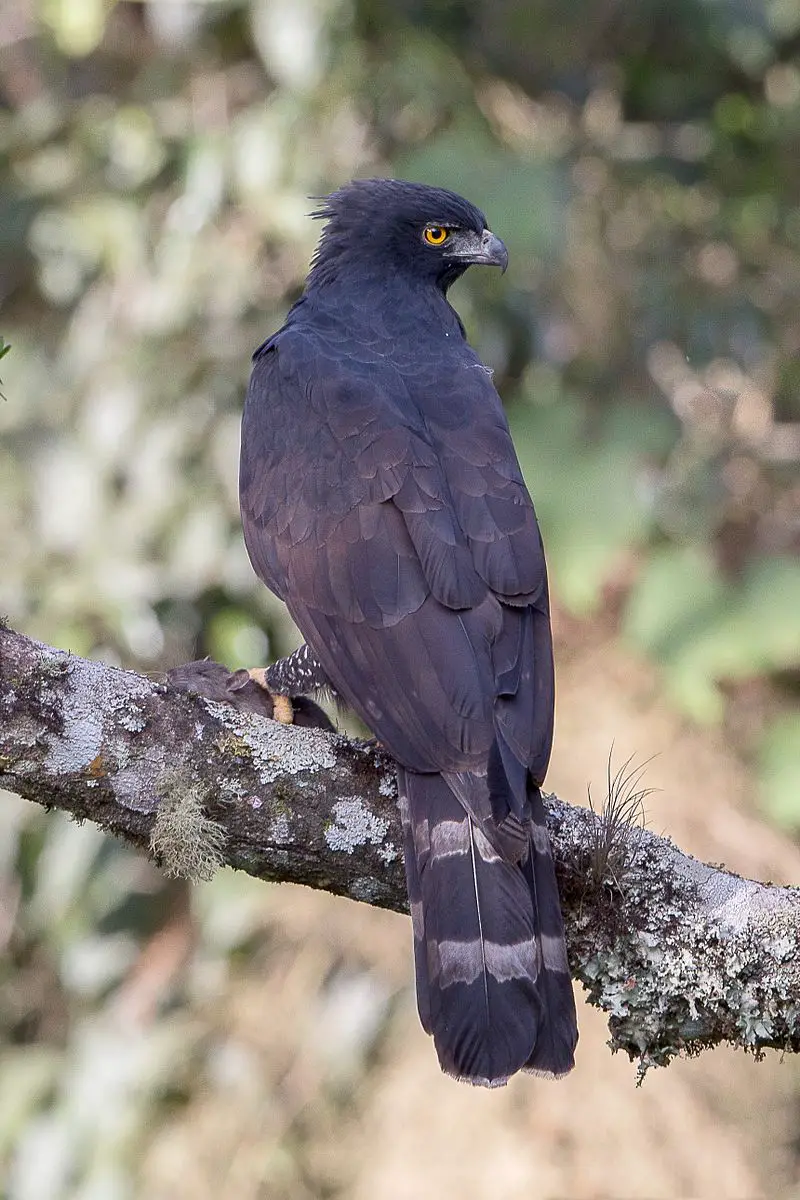
The Black Hawk-Eagle is a majestic bird of prey found throughout Central and South America. With its striking black plumage and distinctive white wing patches, this large eagle can soar gracefully in the air with ease.
It has two known subspecies: S.t tyrannus which is mostly found in Brazil and Argentina, while S. t serus inhabits other parts of Latin America such as Mexico to Colombia, eastern Peru, northern Argentina among others regions.
This beautiful raptor feeds mainly on small mammals like hares or birds but also enjoys carrion when available – it’s an opportunistic hunter that takes advantage of any food sources within reach.
The Black Hawk-Eagle plays an important role in many local ecosystems by controlling animal populations through predation yet they remain vulnerable due to habitat destruction from human activities such as urban expansion or unsustainable agricultural practicesScientific classification:
| Kingdom | Animalia |
| Phylum | Chordata |
| Class | Aves |
| Order | Accipitriformes |
| Family | Accipitridae |
| Genus | Spizaetus |
| Species | S. tyrannus |